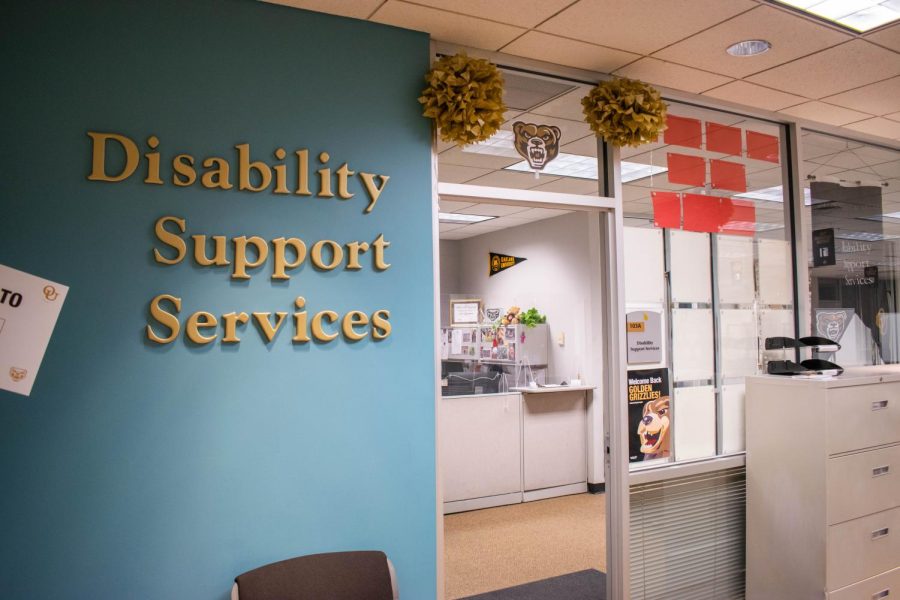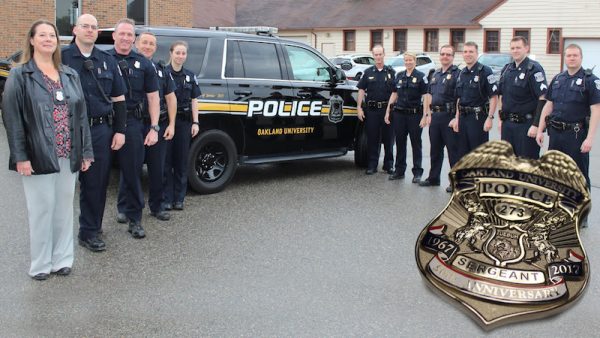Where OU stands on campus accessibility, transportation
The Bear Bus was a mode of accessible transportation on campus before it was discontinued in August of 2020. Many students continue to call for its reinstatement.
The Bear Bus was a vital mode of transportation for campus accessibility and sustainability before the service was discontinued in August of 2020. In May of 2021 students protested on campus, signs in hand calling for its reinstatement. Since then, there hasn’t been a lot of news on where the university stands in regard to Disability Support Services (DSS) and the Bear Bus. So where are we almost a year later?
DSS Director Sarah Guadalupe said the office works with students on a one-on-one basis to meet students’ particular needs.
“Students who are requesting services come in to meet with the staff,” Guadalupe said. “We schedule an appointment with them to review accommodations they have received in the past. We review medical documentation that provides us with whatever medical or intellectual services they might need. A student perhaps with a learning disability might receive some type of testing accommodations, like extra time or a quiet space. Everything is done individually.”
However, student transportation is not a service that the DSS department facilitates. As it stands currently, students are responsible for their own transportation.
While many students have not had to be on campus as frequently with fully online instruction or hybrid classes, transportation accessibility is still a concern, especially with the intent to return fully in-person. Many students have not abandoned their passion for reinstating the Bear Bus.
“We want to push the Bear Bus situation. There would be these claims made of low ridership and how it was unorganized and unreliable,” said Student Body Vice President and Transportation Committee member Murryum Farooqi. “The director of DSS would say only one or two students used it for disability purposes. That is why we want to step up and fund it, because it’s important.”
Low ridership was the reason that the Bear Bus was shut down, but since then, there have been no alternatives offered to make campus accessible to the students who need it.
“When talking to DSS, according to federal law, it’s not the university’s responsibility when students have physical disabilities because they’re not federally mandated to,” Farooqi said. “They keep saying no one rode it, but it doesn’t make sense because it’s a non-working version, so they won’t put in a working version. The university isn’t collecting the data. No one knows who’s deterred from attending OU because we don’t have transportation.”
Engineering student Mia Lewis discussed the benefits of having the Bear Bus. “It was helpful the most during winter,” Lewis said. “There’s a lot of snow on the ground so no one really wants to walk to class. They have certain paths they shovel before the others. It would be very difficult for me to get to class, or I couldn’t get to class because of the weather conditions. I didn’t drive, so that was one of the main difficulties.”
Lewis also said the university has not offered any alternative transportation services to her or other students.
“Last year, all my classes were online,” Lewis said. “This year, so far, classes have been online. If they go back in person, I don’t know what I’m going to do. I’m going to hope that the weather isn’t that bad, otherwise I don’t have any plans yet.”
While the university is conscientious about certain services, there are improvements to be made, especially during winter weather conditions.
“They do a good job at making sure the doors are up and running, same with elevators,” Lewis said. “I would say the main thing [the university can improve on] would probably be shoveling. I remember this one bad day last year where it was snowing a lot, and there would be no way for me to get out. I had to stay inside and Doordash a lot. I couldn’t go to Vandy. Even if I don’t have classes, I need to eat. If I can’t get to the dining hall, it’s an issue. I chose OU in part, because of their accessibility. Not having the Bear Bus makes it harder.”
If the Bear Bus isn’t going to be reinstated, then it is up to the university to provide accessible alternatives in order for disabled students to get around campus. As students hope to return to campus, we’ll see how the university responds to calls for accessible transportation.








Dr. Ken Mitton • Jan 19, 2022 at 12:20 PM
Seems to me that we hear repeatedly of our concern about competing for dwindling numbers of high school graduates. We would be wise to consider becoming a star institution for disability access. I was an undergraduate student of Carleton University in Ottawa, Ontario, Canada, in the early 80s. As early as the mid 70s, that university decided to make buildings and residences very accessible in sun, rain, sleet or snow for anyone. Not only were all the walkways and building entrances made smooth approach, so wheelchairs were not forced to find an alternate entrance, but all buildings were connected by Carleton’s now-infamous underground network. In the middle of a blizzard, a wheelchair resident student could get breakfast in the cafeteria, drop into the underground tunnel system in bad weather and roll to classes, student center, and other events. The student union had one of their restaurants, “The Oasis” in teh tunnel level, and the student center had a few taverns and pubs. (Yes, Canadian schools still have pubs and music joints, and at least one of them is run and owned by the student union!) Tunnels were used by everyone, and included traffic lines and mini stop signs, as the building trades staff used a fleet of electric carts and trailers to travel around campus. This kind of access is so rare that Carelton has a steady stream of dissabled students from across Canada, the US, Hong Kong, Asia Pacific, UK and the EU. Each fall or spring our student union would organize a great public education eye-opener like wheelchair week, where we were all invited to sit in a collection of wheelchairs ourselves to push our way around campus, getting some advice and help from regular wheelchair users ourselves. It is quite true that university executives were always obliged to try out the chairs for TV news consumption, and our dissabled students always made sure to take them to the entrances that were not quite friendly to wheelchairs just yet. After a time, executives knew to expect this.
That did seem to speed up subsequent modifications and fixes to improve access. Here in the United States , 7-million disabled students made up 14% of US public school students. (From 2018 data, Pew Research Center.) I have suggested to make our campus VERY accessible for these students before as a response to several of OU’s requests for staff suggestions since 2001. I could go months, before the pandemic, never seeing a single wheelchair on this campus, where at Carleton that was essentially impossible for any single walk to another building back in the 1980s. Teaching labs also had one long custom lower lab benche for students to do Chem, Physics and Bio labs when in their wheelchair. So, we want to gain some more students post 2022? Consider 7-million students and their families. Accomodate them.